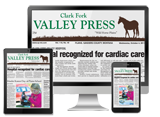Voices of the valley: Planning for growth
Summer 2025. The Clark Fork and Flathead Rivers merge near Paradise in the eastern valley where my family lives.
We know the beginning of summer arrived when volunteer crews cleaned the yards of our Plains neighbors on Beautification Day and the broad, genuine smiles of Sanders County graduating seniors spread across the pages of local papers.
Within a week, Plains Day's parade, booths and sidewalk foods fill a Saturday, and, in unison, the first fire of summer is carefully announced to anxious listeners. This year, the honor went to the Banana Lake Fire that burned a thousand acres of open timber, now in smoldering containment.
Become a Subscriber!
You have read all of your free articles this month. Select a plan below to start your subscription today.
Already a subscriber? Login


